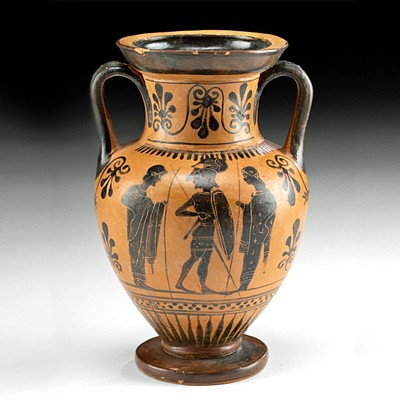19th C. Japanese Edo Shunga Erotic Woodcut - Lovers
Lot 151a
About Seller
Artemis Fine Arts
686 S Taylor Ave, Ste 106
Louisville, CO 80027
United States
Selling antiquities, ancient and ethnographic art online since 1993, Artemis Gallery specializes in Classical Antiquities (Egyptian, Greek, Roman, Near Eastern), Asian, Pre-Columbian, African / Tribal / Oceanographic art. Our extensive inventory includes pottery, stone, metal, wood, glass and textil...Read more
Categories
Estimate:
$2,000 - $3,000
Absentee vs Live bid
Two ways to bid:
- Leave a max absentee bid and the platform will bid on your behalf up to your maximum bid during the live auction.
- Bid live during the auction and your bids will be submitted real-time to the auctioneer.
Bid Increments
| Price | Bid Increment |
|---|---|
| $0 | $25 |
| $300 | $50 |
| $1,000 | $100 |
| $2,000 | $250 |
| $5,000 | $500 |
| $10,000 | $1,000 |
| $20,000 | $2,500 |
| $50,000 | $5,000 |
| $100,000 | $10,000 |
| $200,000 | $20,000 |
About Auction
By Artemis Fine Arts
Mar 9, 2023
Set Reminder
2023-03-09 10:00:00
2023-03-09 10:00:00
America/New_York
Bidsquare
Bidsquare : Exceptional Ancient, Ethnographic, & Fine Art
https://www.bidsquare.com/auctions/artemis-gallery/exceptional-ancient-ethnographic-fine-art-12354
Artemis Fine Arts info@artemisgallery.com
Artemis Fine Arts info@artemisgallery.com
- Lot Description
East Asia, Japan, Edo period, ca. 1810. In the style of Utamaro I or Utamaro II. An original Japanese Shunga woodblock print depicting two lovers with vibrant colors and a strong impression. The center fold indicates it is a leaf that came from an album. Shunga are Japanese artworks that depict an extensive array of sensual encounters, ranging from tender to unmistakably erotic as demonstrated here. Shunga literally means "pictures of spring" - "spring" being a common euphemism for sex. An especially explicit example in the style of Utamaro I or Utamaro II, mounted under glass in an attractive frame. Size (sight view): 10" L x 14.7" W (25.4 cm x 37.3 cm) Size (frame): 15.6" L x 20" W (39.6 cm x 50.8 cm)
Japanese Shunga paintings were inspired by imagery found in Chinese medical manuals going back to the Muromachi era (14th to 16th centuries) as well as the paintings of Tang dynasty Chinese artist Zhou Fang who was known for depicting oversized genitalia. In Japan, the influences go back to the Heian period (794 to 1185) when sex scandals were depicted on narrative handscrolls; however, the form reached its pinnacle during the Edo period (1603 to 1867) and came to and end during the Meiji era (1868 to 1912).
Woodblock prints were created in Japan as early as the 8th century to illustrate texts. By the 18th century Japanese woodblock techniques had evolved, and the first polychrome prints or nishiki-e were commissioned for wealthy patrons of the Edo period. This period was known for marvelous woodblock prints of female beauties, kabuki actors, sumo wrestlers, and courtesans of the infamous pleasure districts. In time the repertoire expanded to include romantic landscapes, flora and fauna, and dramatic historical events. Woodblocks played a major role in the West's perception of Japanese visual culture during the late 19th century when Japonism exerted a powerful influence on French Impressionists such as Degas, Manet, and Monet, Post-Impressionists including Van Gogh, even pioneering Art Nouveau artists such as Toulouse-Lautrec.
Provenance: private Hawaii collection, acquired 2000 to 2010
All items legal to buy/sell under U.S. Statute covering cultural patrimony Code 2600, CHAPTER 14, and are guaranteed to be as described or your money back.
A Certificate of Authenticity will accompany all winning bids.
We ship worldwide and handle all shipping in-house for your convenience.
#177492Mounted under glass in attractive frame. Artwork has not been examined outside the frame but appears to be very good, albeit with crease marks, stains, and wear consistent with age. The center fold indicates it is a leaf that came from an album. Frame has minor scuffs but is otherwise very nice and fit with a suspension wire.Condition
- Shipping Info
-
All shipping is handled in-house for your convenience. Your invoice from Artemis Gallery will include shipping calculation instructions. If in doubt, please inquire BEFORE bidding for estimated shipping costs for individual items.
-
- Buyer's Premium



 EUR
EUR CAD
CAD AUD
AUD GBP
GBP MXN
MXN HKD
HKD CNY
CNY MYR
MYR SEK
SEK SGD
SGD CHF
CHF THB
THB














